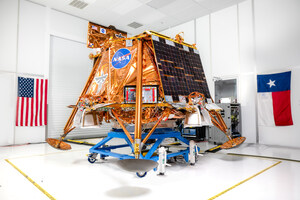WALLOPS ISLAND, Va., April 24, 2015 /PRNewswire-USNewswire/ -- After nearly a month of flight, a massive NASA Super Pressure Balloon (SPB) is closing in on a key milestone of completing the first of many planned circumnavigations of the globe.
Launched from Wanaka Airport, New Zealand, March 26 EDT (March 27 in New Zealand) and flying due east, the balloon is predicted to begin overflight of Australia Friday, April 24 EDT, (Saturday, April 25, in Australia) approaching from the south just west of Melbourne, and flying northerly for several days before eventually continuing east.
"The balloon is healthy and performing as designed," said Debbie Fairbrother, Chief of NASA's Balloon Program Office. "We've had tremendous support from Australia in coordinating the balloon overflight. We're all very thankful for their assistance as we test this balloon technology, which will provide a reliable, low-cost means for conducting scientific investigations at mid-latitudes in a near-space environment."
The balloon is carrying a 5,000-pound (2,268-kilogram) payload below it consisting of tracking and telemetry systems to monitor the balloon's position and health. Speed and position of the balloon is completely dependent on stratospheric winds.
The SPB, made from some 22-acres of very thin polyethylene material and floating at a constant altitude of 110,000 feet (33.5 kilometers) may be visible from the ground, particularly at sunrise and sunset. Anyone may track the progress of the flight, which includes a map showing the balloon's real-time location, at: http://www.csbf.nasa.gov/newzealand/wanaka.htm
The overall mission goal is to validate the SPB technology, capable of flying long duration missions at a constant altitude. The science and engineering communities have previously identified long-duration balloon flights at constant altitudes as playing an important role in providing inexpensive access to the near-space environment for science and technology. NASA's SPB can carry a payload weighing several tons to an altitude above 99.5 percent of the Earth's atmosphere.
The balloon last saw land April 1 during overflight of the southern tips of Chile and Argentina. NASA hopes to fly the SPB for more than 100 days; the current SPB flight duration record is 54 days.
NASA's Wallops Flight Facility in Virginia manages NASA's Scientific Balloon Program with 10 to 15 flights each year from launch sites worldwide. For more information on the NASA Scientific Balloon Program, visit:
http://sites.wff.nasa.gov/code820/index.html
Logo - http://photos.prnewswire.com/prnh/20081007/38461LOGO
SOURCE NASA
Related Links
WANT YOUR COMPANY'S NEWS FEATURED ON PRNEWSWIRE.COM?
Newsrooms &
Influencers
Digital Media
Outlets
Journalists
Opted In




Share this article